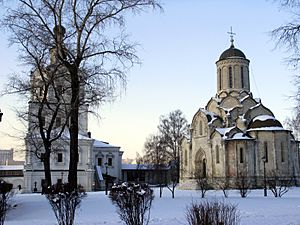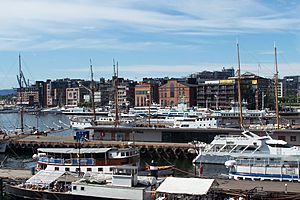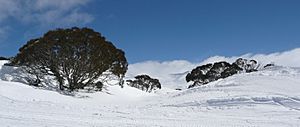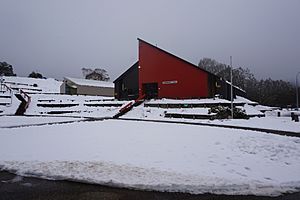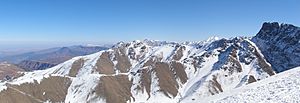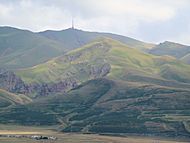Continental climate facts for kids
Continental climates are types of weather found far from oceans. This means they have big changes in temperature between summer and winter. Imagine a place where the winds blow mostly over land, not water. This makes the temperatures much more extreme.
These climates are often found in the middle parts of continents. You can see them in places like the eastern United States and mainland China. They also appear in higher, mountainous areas around the world.
Winters in these regions are usually very cold. It's often cold enough for snow to stay on the ground for a long time. Summers, however, can be quite warm. Rain or snow (called precipitation) usually happens moderately. Most of it falls during the summer months. Some places, like the upper east coast of North America, get rain evenly all year. These are known as humid continental climates. A few areas, like parts of the Pacific Northwest and countries in the Middle East and Central Asia, get most of their rain and snow in winter.
Contents
Seasons in Continental Climates
The exact time when spring or autumn arrives can change. It depends on how far north or south a place is (its latitude). It also depends on how high up it is (its elevation). For example, spring might start in early March in the southern parts of these areas. But in the north, it might not arrive until May.
These areas usually get between 600 mm (24 inches) and 1200 mm (47 inches) of precipitation each year. A lot of this precipitation falls as snow during the winter. So, remember: cold winters and warm summers are key!
Understanding Köppen Climate Types
Scientists use the Köppen climate classification system to group climates. Most continental climates fit into specific Köppen types. These include Dfa and Dwa for places with cold winters and hot summers. The "w" means they have very dry winters, which is common in China.
Other types are Dfb and Dwb, which have cold winters but warm, not hot, summers. Again, "w" means dry winters. There are also dry summer continental climates, like Dsa and Dsb. These are found in high mountains near Mediterranean climates. Sometimes, a semi-arid climate (called BSk) can also be seen as continental if its winters are cold.
For a climate to be called continental, the average temperature of its coldest month must be below −3°C (27°F). Also, at least four months must have an average temperature of 10°C (50°F) or higher. Some scientists use 0°C (32°F) instead for the coldest month.
How Continental Climates Form

Continental climates happen when cold air masses move in during winter. In summer, warm air masses form because of strong sun and long days. Places with these climates are usually far from the ocean's moderating effects. Think of cities like Omaha, Nebraska in the USA or Kazan, Russia.
Sometimes, even if a place is near the coast, the winds blow from land to sea. This means the ocean's influence doesn't reach inland much. New York City is an example of this. These regions get very warm in summer, sometimes as warm as tropical places. But in winter, they become much colder than any other climate at the same latitude.
Nearby Climates
Continental climates gradually change into other climate types. Towards the equator, where winters are less harsh, they become subtropical climates. Where there isn't enough rain for tall grasslands, they turn into semiarid climates.
In Europe, these climates can shift into oceanic climates towards the west. Oceanic climates are more affected by the ocean's mild air. The subarctic climate (Köppen: Dfc) is very cold and dry in winter. But it has at least one month above 10°C (50°F). It can be thought of as a type of continental climate.
Places with a Continental Climate
North America
- Canada: Many parts of southern Canada, from the Rocky Mountains to Atlantic Canada.
- Major cities: Whistler, Prince George, Kamloops, Calgary, Edmonton, Fort McMurray, Saskatoon, Regina, Winnipeg, Kenora, Thunder Bay, Sault Ste. Marie, Greater Sudbury, North Bay, Ontario, Timmins, Sarnia, London, Ontario, Kitchener, Ontario, Toronto, Niagara Falls, Kingston, Ottawa, Val-d'Or, Montreal, Sherbrooke, Quebec City, Saguenay, Sept-Îles, Fredericton, Moncton, Halifax, Sydney, Nova Scotia, Charlottetown, St. John's.
- United States: Much of the northern US, including parts of Alaska. Also found at high elevations in Oregon, California, Arizona, and along the Appalachian Mountains.
- Major cities: Spokane, South Lake Tahoe, Bridgeport, Carson City, Flagstaff, Idaho Falls, Wallace, Billings, Cheyenne, Salt Lake City, Aspen, Denver, Fargo, Sioux Falls, Omaha, Kansas City, Des Moines, Minneapolis, Green Bay, Milwaukee, St. Louis, Chicago, Indianapolis, Detroit, Cincinnati, Lexington, Columbus, Cleveland, Youngstown, Pittsburgh, Erie, Scranton, Wheeling, Charleston, West Virginia, Oakland, Maryland, Boone, North Carolina, Buffalo, Rochester, Syracuse, Albany, New York City (borders a humid subtropical climate), Montpelier, Concord, Hartford, Providence, Worcester, Boston, Portland, Maine, Augusta, Maine, Juneau, Alaska.
South America
- Argentina: Puente del Inca, Mendoza Province.
- Chile: Balmaceda.
Europe
- United Kingdom: Some high areas in Scotland.
- France: Chamonix.
- Belgium: Bertrix.
- Italy: Bruneck, Cortina d'Ampezzo.
- Austria: Vienna (borders an oceanic climate and a humid subtropical climate), Innsbruck, Salzburg (borders an oceanic climate).
- Switzerland: Zürich (borders an oceanic climate), Lausanne, Bern.
- Germany: Berlin (borders an oceanic climate), Munich, Garmisch-Partenkirchen.
- Denmark: Copenhagen (borders an oceanic climate).
- Norway: Oslo, Trondheim, Lillehammer.
- Sweden: Stockholm, Gothenburg.
- Finland: Helsinki, Turku.
- Estonia: Tallinn.
- Latvia: Riga.
- Lithuania: Vilnius.
- Belarus: Minsk, Grodno.
- Ukraine: Kiev, Kharkiv, Lviv.
- Czech Republic: Prague.
- Poland: Warsaw, Wrocław, Szczecin.
- Slovakia: Bratislava.
- Hungary: Budapest (borders an oceanic climate or humid subtropical climate).
- Bulgaria: Sofia, Pleven.
- Croatia: Zagreb.
- Romania: Bucharest.
- Bosnia and Herzegovina: Sarajevo, Banja Luka (borders a humid subtropical climate).
- Moldova: Chișinău.
- Serbia: Belgrade.
- Russia: Most of southern Russia, except the Black Sea coast.
- Major cities: Moscow, Saint Petersburg, Kazan, Novosibirsk, Ulan-Ude, Abakan, Vladivostok.
Oceania
- Australia: High areas like the Victorian Alps (between Victoria and New South Wales) and in Tasmania.
- Major cities: Collinsvale (borders an oceanic climate), Mount Buller (borders a subarctic climate), Kiandra, Cabramurra, Charlotte Pass (borders a subarctic climate).
Africa
- Morocco: Oukaimeden, Khenifra, Imilchil, and Azilal.
Middle East
- Turkey: Hakkâri, Muş, Erzurum, Ardahan, Sivas, Yüksekova, Van, Kayseri, Bolu.
- Iran: Sanandaj, Saqqez, Arak, Ardabil, Tabriz.
Asia
- Georgia: Gori.
- Armenia: Yerevan, Gyumri.
- Azerbaijan: Nakhchivan.
- Kazakhstan: Astana, Almaty, Oskemen, Oral.
- Kyrgyzstan: Bishkek, Naryn.
- Afghanistan: Kabul.
- Uzbekistan: Nukus, Andijan.
- Pakistan: Skardu.
- India: Leh, Dras.
- Mongolia: Ulaanbaatar, Ulaangom.
- China: Ürümqi, Turpan, Shijiazhuang, Lhasa, Beijing, Harbin, Tianjin, Changchun, Heihe, Qiqihar, Xining.
- North Korea: Pyongyang, Nampo.
- South Korea: Seoul, Pyeongchang County.
- Japan: Mostly in the Hokkaido region and high areas in mainland Japan.
- Major cities: Sapporo, Asahikawa, Nayoro, Kushiro, Obihiro, Kitami, Abashiri, Wakkanai, and Nemuro.
-
The Forks, with St. Boniface Cathedral in the background in Winnipeg
-
Ice skaters on the frozen Rideau Canal, looking south from Laurier Avenue Bridge in Ottawa
-
The Chicago River, with the Near North Side and Streeterville on the right, the Chicago Loop, Lakeshore East, and Illinois Center on the left, and Trump Tower at the jog in the river in the center. This view is looking west from Lake Shore Drive's Outer Drive Bridge.
-
Times Square in Manhattan, New York City
-
Boone as seen from Howard's Knob
-
Suncor Energy Centre in Calgary
Images for kids
-
Downtown Calgary from Southern Alberta Institute of Technology (SAIT) campus
See also
 In Spanish: Clima continental para niños
In Spanish: Clima continental para niños






